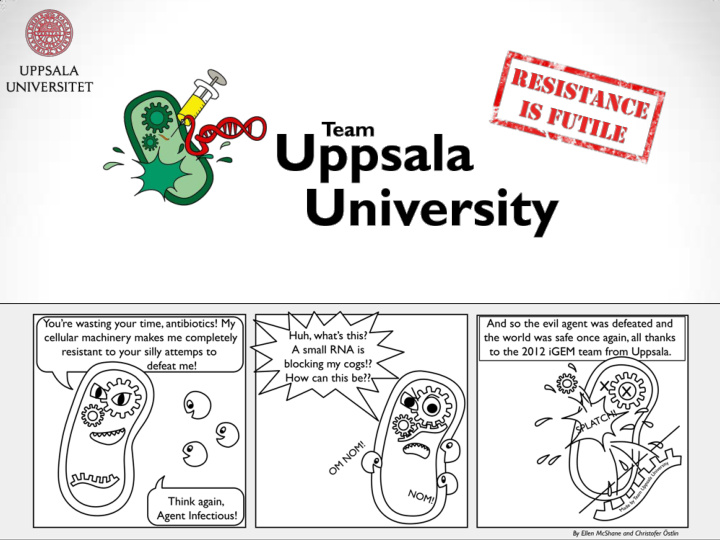



Stalled antibiotics development • ”A solved problem” • No new classes of antibiotics for 30 years
Stalled antibiotics development • ”A solved problem” • No new classes of antibiotics for 30 years Walsh & Fischbach (2009) Sci. Amer.
Stalled antibiotics development • ”A solved problem” • No new classes of antibiotics for 30 years Accelerating resistance development • 25 000 deaths yearly in EU alone • € 1,5 billion • We might soon be facing a post-antibiotic era ECDC/EMEA (2009) The bacterial challenge: time to react
macrolides beta-lactams erythromycin pencillin, ampicillin, cefotaxime aminoglycosides sulfonamides ”sulfa” kanamycin, streptomycin trimethoprim tetracyclines disinfectants arsenic silver copper Adapted from Sandegren et al. (2012) J. Antimicrob. Chemother.
Our target AAC(6’) Kan R Adapted from Sandegren et al. (2012) J. Antimicrob. Chemother.
An antibiotics adjuvant 100 96 90 MIC Kanamycin (µg/ml) 80 70 60 50 40 30 20 8 10 0 Control sRNA
Small RNA regulation
Small RNA regulation
Randomizing a sRNA library Sharma, V, et al. (2011) ACS Synth. Biol.
Randomization of a sRNA library
Randomization of a sRNA library
Screening system Engineered sRNA library Reporter vector
Screening system Engineered sRNA library Reporter vector
Screening system Engineered sRNA library Reporter vector
Fluorescence Activated Cell Sorter
Fluorescence Activated Cell Sorter
Small RNA screening
Why downregulation of fluorescence? • Interaction with coding region of SYFP2 SD • Interaction with truncated resistance mRNA SD
Modelling sRNA-mRNA Interactions 1 2 3 Sequencing Modelling Predictions IntaRNA
Predicted binding sites SD
Predicted binding sites SD
Predicted binding sites SD
Clinical plasmid experiment ESBL plasmid sRNA E.coli – MG1655 /pUUH239.2
Results Downregulation of kanamycin resistance by >90% 100 96 80 MIC Kanamycin (µg/ml) 60 40 19 20 12 8 0 Control UU17 UU37 UU55 (Native sRNA) Engineered sRNA clones
Interaction Modeling SD 78 % downregulation Shine-Dalgarno Start Codon Binding region (predicted)
Interaction Modeling SD 58 % downregulation Shine-Dalgarno Start Codon Binding region (predicted)
Interaction Modeling SD 82 % downregulation Shine-Dalgarno Start Codon Binding region (predicted)
Interaction Modeling SD 83 % downregulation Shine-Dalgarno Start Codon Binding region (predicted)
Interaction Modeling SD UUconstr. 50 % downregulation Shine-Dalgarno Start Codon Binding region (predicted)
RBS
RBS UUconstr.
Common Characteristics? Consistent hairpin formation in binding domain
Thermodynamic Hypothesis Adapted from Guillermo et. al., (2012), PNAS
Under development • TALENs – Transcription Activator-Like Effector Nucleases
Under development • TALENs • Targeting gene networks
MarR superrepressor 2.5 • Multi Resistance MIC Ciprofloxacin (µg/ml) 2.0 2.0 Operon • Non-releasing 1.5 MarR mutant 1.0 (G95S) 0.44 0.5 0.0 Control MarR Mutation as reported in Sulavik et al (1995) Mol. Med.
Delivery systems • Conjugative plasmid • Engineered phage Lu & Collins (2009) PNAS
Human practice • Blog
Human practice • Blog • Scandinavian iGEM weekend
Favorite parts • Low copy backbones – Missing from the registry – Low copy backbones pSB4X 15 – Flp recombinase sites pSB4X15 (FRT) – lacIq repression pSB4X15 Iq – Thermosensitive pSB 8 X15
Favorite parts • Low copy backbones – Missing from the registry – Low copy backbones pSB4X 15 – Flp recombinase sites pSB4X15 (FRT) – lacIq repression pSB4X15 Iq – Thermosensitive pSB 8 X15
Favorite parts • Low copy backbones • aeBlue reporter protein Sea anemone Actinia equina
Favorite parts • Low copy backbones • aeBlue reporter protein • Modular sRNA screening system – J23101-spot42 – RFP-linker-SYFP2
Favorite parts • Low copy backbones • aeBlue reporter protein • Modular sRNA screening system – J23101-spot42 – RFP-linker-SYFP2
The team Supervisors Donor
Resistance to our system? T o minimize the risk of resistance development to our system, we propose to • Combine two sRNA with different binding to the mRNA • Target on transcriptional and translational level – sRNA+super-repressor
Resistance to our system? • Faster to develop sRNA than new antibiotics
RFP expression by backbone Grown overnight, IPTG (0,5 mM), Cm (12 µg/ml), triplicates (-IPTG) or quadruplicates(+IPTG).
Plasmid yield and color development From fluorescence +IPTG experiment.
IPTG induction of pSB4C15Iq Grown overnight, IPTG (0,5 mM), Cm (12 µg/ml)
Plasmid loss at 42° C
E-test Spot42 control sRNA UU37
Recommend
More recommend